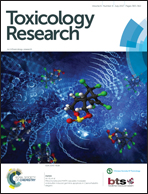Zinc is a determinant of the cytotoxicity of Ziram, a dithiocarbamate fungicide, in rat thymic lymphocytes: possible environmental risks
Abstract
Ziram, one of the dithiocarbamate fungicides, is widely applied to agriculture because this agent protects various crops from fungal infections. Risks of dithiocarbamate biocide use are of concern. It was previously reported that Ziram increased the intracellular concentration of Zn2+. Therefore, we cytometrically studied the mechanism of Zn2+-dependent lethal actions of Ziram on rat lymphocytes at environmentally relevant Zn2+ levels. Membrane and cellular parameters of rat lymphocytes were estimated by flow-cytometric techniques with appropriate fluorescent probes. The Ziram-induced increase in cell lethality was completely attenuated by Zn2+ chelators. A significant increase of cell lethality was found on the simultaneous application of Ziram at a sublethal concentration and ZnCl2. The combination of Ziram and ZnCl2 increased the cellular superoxide anion content and decreased the cellular GSH content, which possibly caused the increase in cell lethality. The zinc concentrations under the present experimental conditions were comparable to the environmentally relevant concentrations found in rivers. Therefore, the environmental level of zinc may be critical in estimating the toxicity of Ziram to wild animals.



 Please wait while we load your content...
Please wait while we load your content...